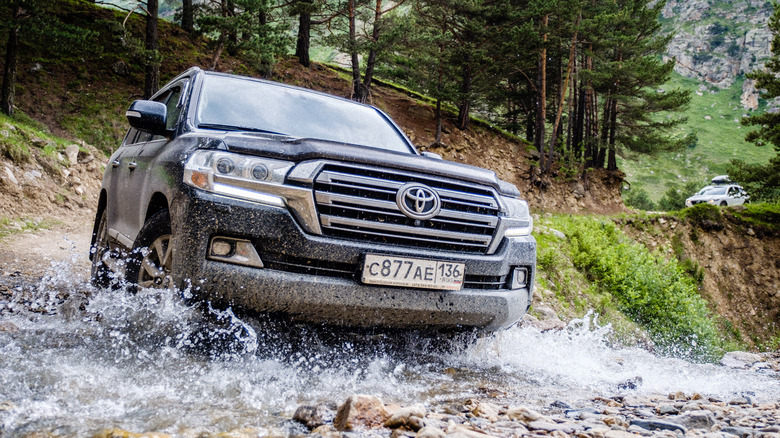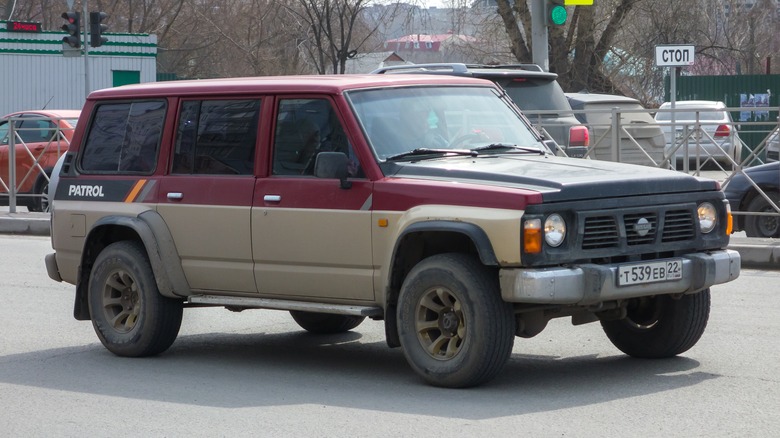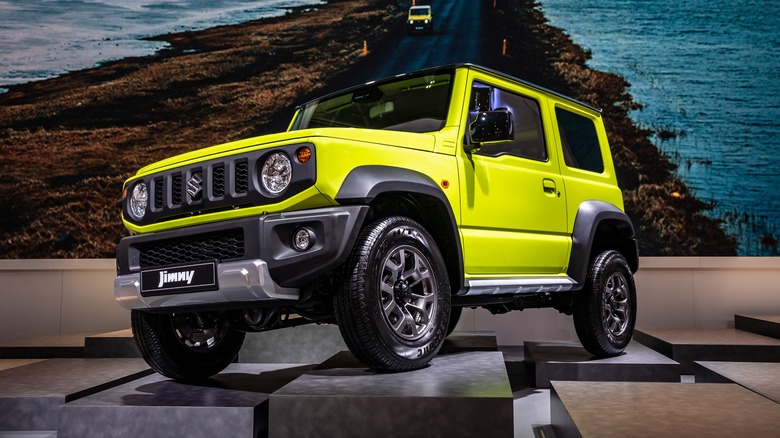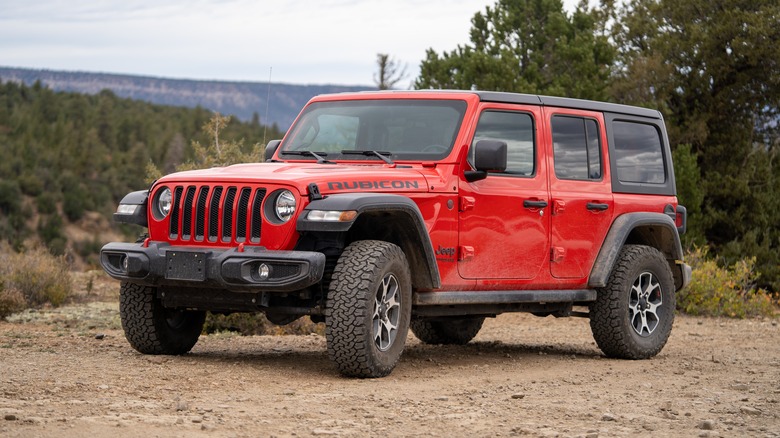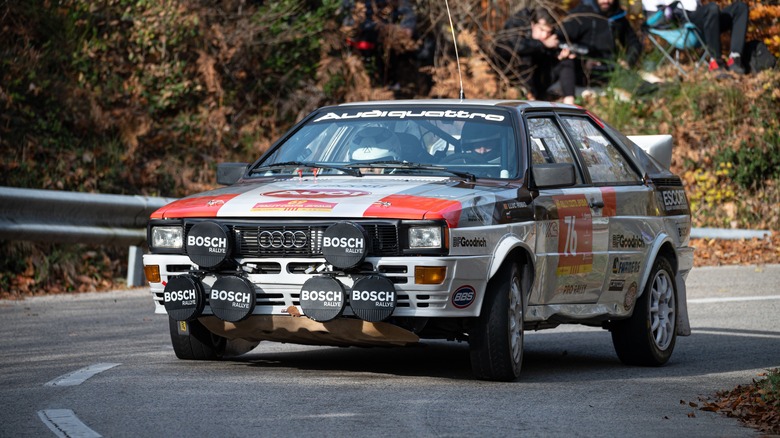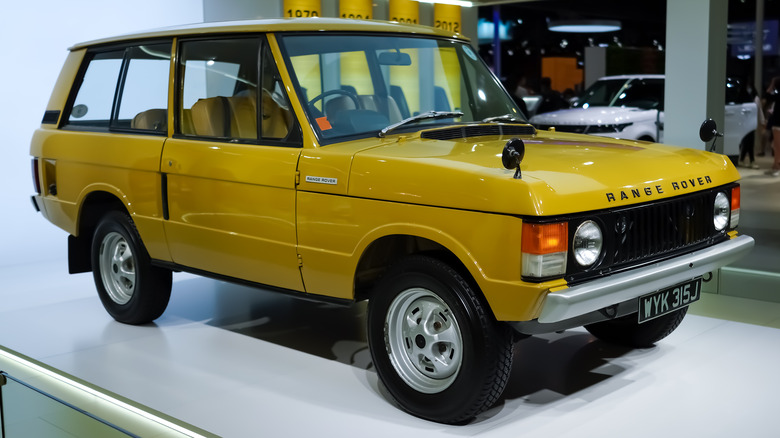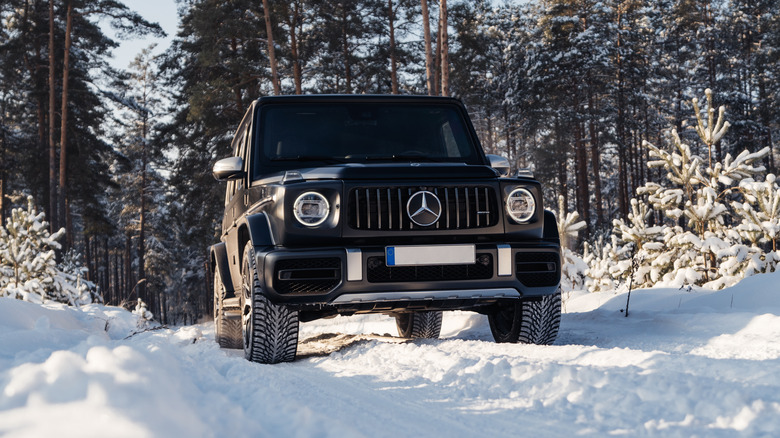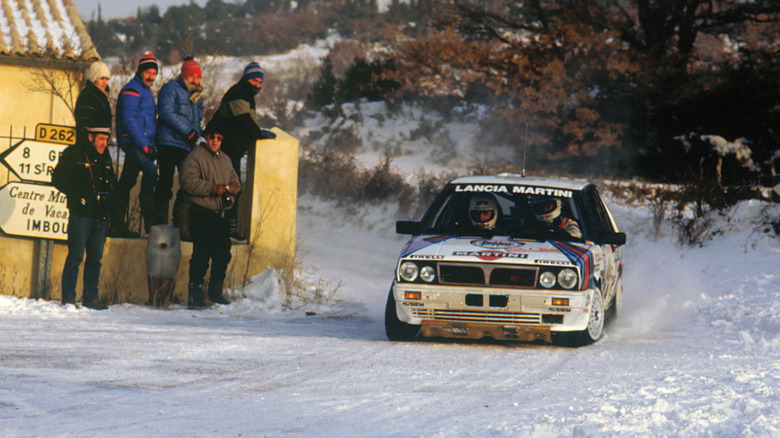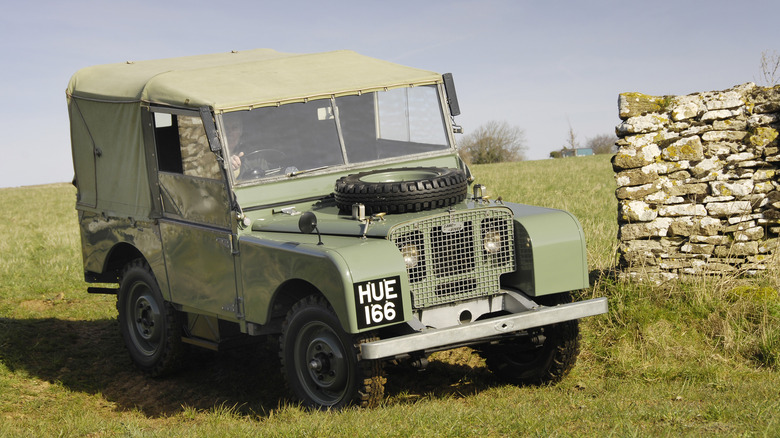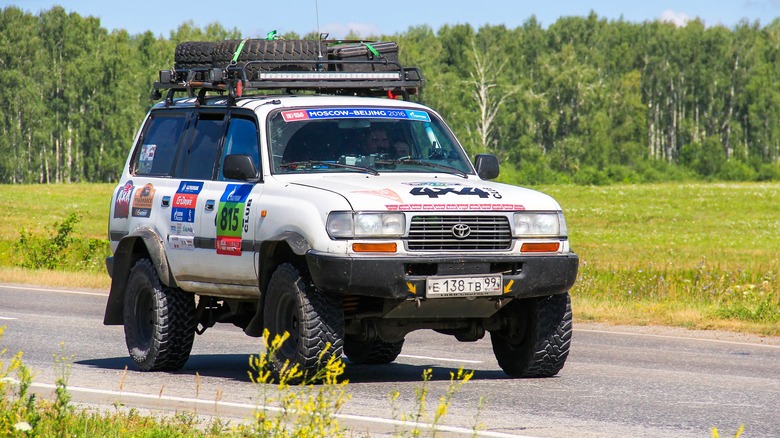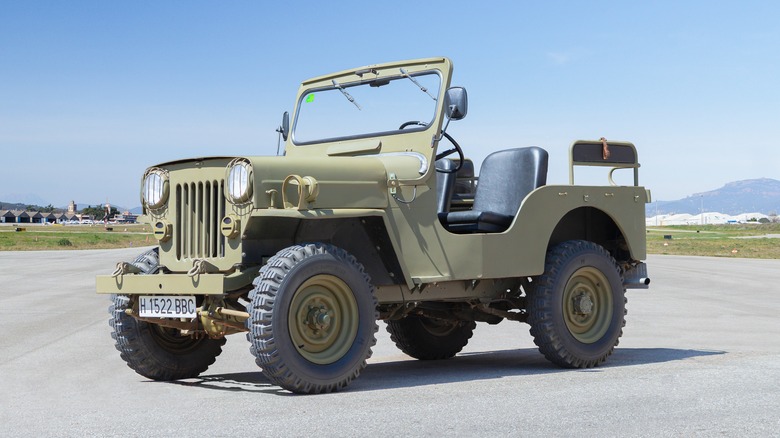The 10 Best 4WD Cars Ever Made, Ranked
In today's market, cars that send power to all four wheels are available in almost every segment. However, most modern cars are AWD (all-wheel-drive), meaning they send varying amounts of power to each axle. True 4WD (four-wheel-drive) cars send equal amounts of power to each axle, and they're usually the most capable layout when it comes to conquering the roughest terrain. As such, most 4WD systems are found on SUVs, but not all of them.
There were a handful of attempts to create a 4WD system in the early days of car manufacturing, but the vehicle that's often credited with being the first mass-produced 4x4 is the World War II-era Willys Jeep. From there, a number of rival manufacturers sprang up to launch their own versions of the Jeep design, including Land Rover in Britain and Toyota in Japan. Each new 4WD car is built on Jeep's early blueprint in a unique way, with the following ten cars, in particular, standing out as the most innovative examples.
Nissan Patrol
Its name might not carry the same weight as the Land Cruiser, but just like the Toyota, Nissan Patrols are often found traversing the world's toughest terrain. The first-generation Patrol was launched in 1951, the same year as the Land Cruiser, and it's been in constant production ever since. Originally, the Patrol was sold in Japan only, but after its initial domestic success, it was launched in a range of export markets including Australia and the Middle East.
It's these export markets where the Patrol really gained a reputation as an excellent no-nonsense off-roader, especially with the launch of the GQ generation car in 1987, reports WhichCar. The Patrol GQ beat Toyota to the punch by offering coil springs when the 60 Series Land Cruiser only offered leaf springs, and sales skyrocketed as a result. In recent years, the Patrol's most rapidly expanding market has been the Middle East, and that's resulted in a number of region-specific special editions, including the 428 horsepower Patrol NISMO. Unfortunately, Nissan has no plans to launch the current-gen Patrol in the U.S., although the American-market Armada shares the same platform and many of the Patrol's underlying components.
Suzuki Jimny
The Suzuki Jimny can trace its roots back to 1970, when the Japanese company unveiled its first compact 4x4, the LJ10. It was designed to reach small spaces that larger 4x4s of the time couldn't access, and it was initially powered by a two-stroke 360cc engine (via Motoring Research). That meant it wasn't fast, but with a weight of just 600 kg (1,323 lb), it was great at scampering over rough terrain. Initially, the car was only sold in Japan, but in 1975, Suzuki opened its first overseas production facility to make Jimnys in Pakistan. It was launched in the U.S. as the Samurai in 1985, where it quickly became a favorite among buyers looking for a small, cheap 4x4.
Suzuki has remained true to the "lightweight, small engine" formula ever since, with the latest generation of the Jimny packing a 1.5L four-cylinder engine and featuring the same boxy proportions that set the car apart from its competition. It rides on a ladder frame and features engageable 4WD with a low-range transfer gear, ensuring it's just as capable on rough terrain as previous generations were. Suzuki pulled out of the American market in 2012 due to low demand, so the Jimny is, unfortunately, forbidden fruit for those living Stateside.
Jeep Wrangler
The Wrangler is arguably the most direct current descendent of the original Jeep, and it keeps many of the features that made the original CJ series such a hit across the country and abroad. The first-generation Wrangler launched in 1987, replacing the aging CJ-8 "Scrambler" which was popular but had become outdated in comparison to the rest of the SUV market. The goal was to make a Jeep that was equally capable on all terrains, but was more refined to drive on the road, and was less thirsty than its gas-guzzling predecessor.
The first-generation Wrangler (YJ) ticked all those boxes, although its square headlamps made it less endearing to some fans of the brand. The second-generation TJ fixed the headlamp issue and added coil spring suspension for a more refined on-road experience. By the time the JK was unveiled in 2007, the Wrangler had already cemented its reputation as one of America's best-loved off-roaders, even if its 3.8L V6 engine was glacially slow compared to some of its rivals. The most recent JL Wrangler debuted in 2017 and with it came the 4xe, the first electric Jeep and a sign of the brand's impending EV future.
Audi Quattro
Before the Quattro, 4WD vehicles were mostly clunky, slow off-roaders which had little concern for speed or on-road handling. Audi changed all that. The Quattro project started with an Audi 80 that was fitted with the drivetrain from the VW Iltis, a military 4x4. This first mule quickly demonstrated its superior capability on snow and ice, and Audi bosses gave the green light for further development, although at this point they reportedly weren't convinced there was much sales potential in the idea.
The initial mule was still clunky to drive, so Jörg Bensinger, a senior Audi engineer, set about creating a four-wheel drive system that was lighter and faster. The result was the Quattro system, and it was put into production in a car of the same name in 1980. It also made its debut in the World Rally Championship in 1981 and immediately saw success, claiming two drivers' and manufacturers' titles over the following three years. The success of the Quattro proved not only that 4WD was a viable option for passenger cars, but also that the right 4WD system could be incredibly quick. It opened the door for a wave of 4WD rally cars that would debut over the following decade, with the technology behind them trickling down into Audi's passenger cars, too.
Land Rover Range Rover
The original Range Rover had plenty of high-profile fans, with the Royal family's Prince Charles famously driving one while courting Princess Diana. It's generally considered to be the world's first luxury SUV, although when it first launched in 1970, it was still a rather agricultural vehicle. Nonetheless, its popularity with Britain's wealthy farmers and landowners led Land Rover to quickly introduce more upmarket features, with a level of fit and finish that was unheard of for a 4x4 at the time.
It might have featured more creature comforts than any other car of its type, but the Range Rover never lost any of its all-terrain capability. A modified Range Rover won its class in the 1977 London-Sydney marathon, and a few years later, another race-prepped example won the inaugural Paris-Dakar Rally. Even with its early successes, it took until 1987 for the Range Rover to be introduced to North America. In recent years, it's become the daily driver of choice for celebrities ranging from actor Vin Diesel to Canadian pop star Justin Bieber, but even the newest models are still surprisingly capable off the tarmac.
Mercedes-Benz G-Class
Much like the Range Rover, the Mercedes-Benz G-Class (or G-Wagen as it's sometimes known) is now a more common sight in Los Angeles traffic than anywhere else. It wasn't always that way, however. The G-Wagen was originally designed for the German military, but civilian versions of the vehicle later became popular with farmers. Older models were simpler in their construction and therefore tend to be more reliable, and simpler to fix when things do go wrong. Newer G-Class models are too expensive for all but the most deep-pocketed of enthusiasts anyway, as a well-specced model will now stretch comfortably into six figures.
Anyone looking to buy a G-Class primarily for off-road purposes still has a few options, with the best route being to find an ex-Army example. Mercedes-Benz still makes a stripped-back version of the car for various world militaries, and every so often, a batch of surplus vehicles comes up for sale for a small fraction of the regular G-Class' asking price.
Lancia Delta HF
If the Audi Quattro proved that making a rally car with 4WD was a good idea, then the Lancia Delta HF proved that it was simply uncompetitive to do anything else. The Delta was introduced under Group A regulations in 1987, the year after Group B was banned. Its four-wheel drive system and 2.0L turbocharged engine proved to be unstoppable, winning six consecutive Constructors' titles from 1987 onwards. The last of those titles wasn't even won by the factory team, which pulled out of the WRC in 1991. It was instead claimed by the privateer Martini Racing team, who ended up being responsible for one of rallying's most iconic liveries in the process.
In total, the Lancia Delta HF and HF Integrale won 46 rallies, making it the most successful car in World Rally Championship history. Its dominant performance set the template for rallying's future, and today, both the racing and production versions of the car are highly sought-after collectors' items.
Land Rover Series I
After seeing the success of the Willys-Overland Jeep in World War II, British manufacturer Rover attempted to create its own version of the military off-roader that was more suited to traversing the UK's muddy terrain. The resulting SUV was christened the "Land Rover," and it debuted at the Amsterdam Motor Show in 1948. It quickly caught the attention of farmers and landowners, and within a year, Rover received orders for 8,000 vehicles. The British Army also purchased a small number of vehicles, starting a decades-long relationship between the military and the manufacturer that still continues to this day.
The Series I was rudimentary to drive even for its era, with just 50 horsepower on tap and gear changes requiring the use of a lever that stuck out of the bare metal floor. It succeeded in the most important aspect of its brief, however: It performed better on muddy British farmland than any other vehicle at the time. The first Series I ever made, nicknamed "Huey" thanks to its license plate that reads, "HUE166," is on permanent display at the British Motor Museum in Warwickshire, England.
Toyota Land Cruiser
The Land Cruiser is the longest-produced vehicle in Toyota's history, having debuted in 1951 and been in production ever since. It was originally conceived as a transport vehicle for the Japanese Police Force, but with its all-terrain capabilities and bulletproof reliability, it soon became popular among civilians. Over 10 million Land Cruisers have been sold worldwide to date, according to Toyota Magazine, and with the brand unveiling the new 10th-generation SUV in 2022, that figure will continue to increase.
Every generation of the Land Cruiser has remained true to the nameplate's reputation for reliability and capability, and picking the "best" generation is largely down to personal preference. However, in pure off-road terms, the general consensus is that the 80 Series offers the best package. In an interview with WhichCar, Toyota's chief engineer for the 300 Series even acknowledged the 80 as the most capable, calling it the "guidepost" for the new generation's development. Thanks to their longevity and cult status, old Land Cruisers tend to hold their resale value much better than many rival 4x4s, with the oldest and rarest models being particularly collectible. A 1994 Land Cruiser 80 with just 1,000 miles recently sold for a staggering $136,000 at auction, setting a new record in the process.
Willys-Overland Jeep
It's hard to overstate just how crucial the Willys-Overland Jeep was in the history of modern 4WD cars. The original Jeep was designed in World War II, as a response to a request from the U.S. government for all-terrain military vehicles. Willys-Overland beat out competition from Ford and Bantam to win the contract for Jeep production and ended up delivering over 300,000 examples before the war ended.
The Jeep's success stemmed from its versatility. It could be easily adapted into an ambulance, a supply vehicle, or a fire truck with minimal modifications. After the war, a civilian version would be developed that kept this versatility, and it quickly found success in the domestic market and abroad. This in turn led to foreign manufacturers developing their own versions of the design, spawning the Land Rover, the Land Cruiser, and the countless other 4WD cars that can be found tackling rough terrain all over the world today.
